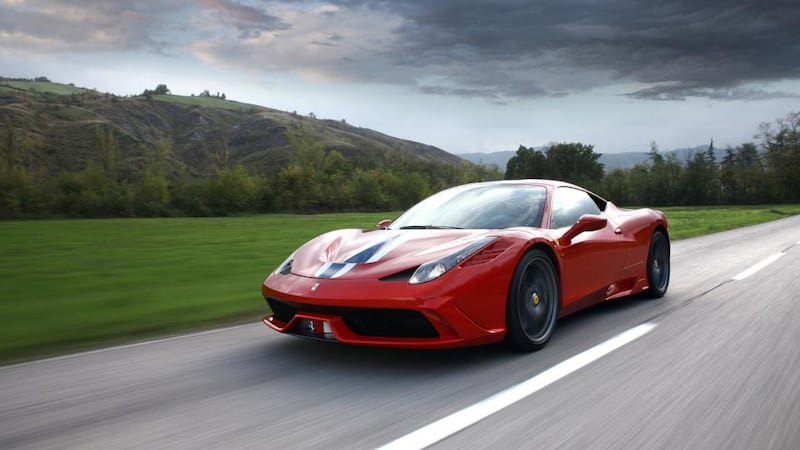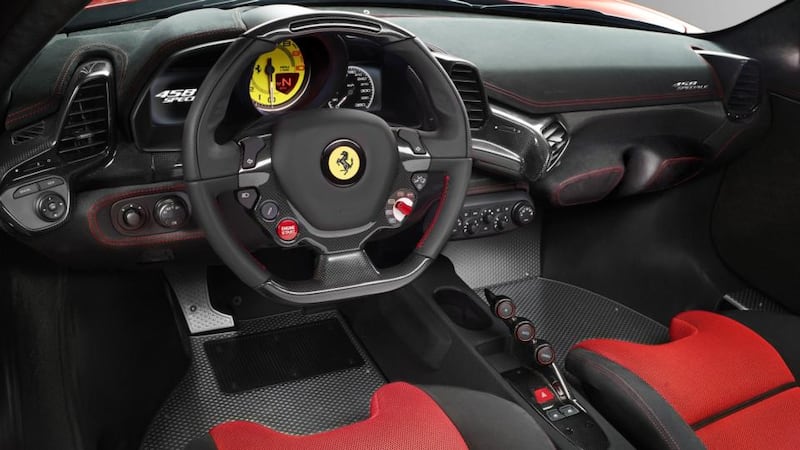Ferrari has a long history of making stripped-out versions of its fastest V8 coupes; a history that can count the 360 Challenge Stradale and the F430 Scuderia amongst its alumni. But the 458 Speciale is unquestionably the best. It's 90kg lighter than the not-heavy 458 coupe. Rev it to 9,000rpm and you'll find 445kW of power waiting for you. And it's incredibly fast, all the time, everywhere.
Confession time: I’ve never had a hankering for Ferraris. True, I lived within 20km of the place for six years and, true, I’ve respected what they’ve achieved and, equally true, its machinery has taken quantum leaps in the last decade.
But something just never gelled for me, partly because what’s also true is that I love cohesive cars that deliver a holistic driving experience that’s more than the sum of their parts. I don’t particularly fall for cars that have one dominant area, and Ferraris have always been dominated by their engines. I also found their shapes a bit evolutionary or contrived for drama, especially compared to what they were doing in the 1960s.


That’s changed. I have more than a hankering for the 458 Speciale. I now know, without hesitation, what would fill the first available space in my fantasy garage. That’s because the 458 Speciale isn’t just Speciale. It’s damned near perfect. No car I’ve ever driven has completely nailed all of its intended functions as well as this car.
It’s the first car I’ve ever driven, in more than 20 years at this game, where I wouldn’t voluntarily change a single thing. If pressed, maybe I’d change the velvet-touch plastic surround on the HVAC controls to carbon-fibre. Maybe.
That’s because the 458 Speciale picks up and runs from where the 458 stops. It’s phenomenal.
You won’t fail to notice the engine, of course. It’s a derivative of the 458’s 4.5-litre, hugely oversquare V8 and it smashes the old 100 horsepower/litre barrier. Actually, it almost smashes the 100kW/litre barrier, with 445kW of power arriving at the 9000rpm rev limiter. Then there’s the torque, because this engine is more than a screamer and has 540Nm available at 6000rpm, but is solidly strong beneath that.
There has been work done on the engine to deliver more urge and 8kg less weight. There’s more power but the same CO2 emissions, with Ferrari’s own in-house software development responsible for managing knock on every single cycle. It will give its best on 98 octane, but can live on 95 if it needs to.
They’ve worked inside the engine on hardware, too, with balanced pistons now having 33 per cent more tensile strength, but also on the exhaust, with 25 percent less back pressure.
Then there’s the seven-speed, dual-clutch transmission, which boasts shifts that are 20 percent faster on the way up the box and 44 percent faster on the way down again. That’s a bit illusory, though, because the dual-clutch system delivers zero-shifts anyway. What Ferrari has actually worked on is the speed of the software and its response to the shift paddles.
The flipside to the power is that the 458 Speciale is 90kg lighter than the 458, with a dry weight of just 1290kg. Much has been stripped to get down to the sub-1300kg level and much has been modified.
The wheels are lighter and the custom-made tyres are lighter and grippier than ever before, delivering six percent more dry grip and five percent more wet lateral grip, so that it pulls 1.33g of lateral acceleration, up from the F430 Scuderia’s 1.22.
Stripping out the interior and replacing the seats with carbon-shelled units saved 20kg, they found 8kg in the engine and another 20kg around the body, including using Lexan rear glass and thinner windscreen glass. And there’s a full carbon-fibre underbody, plus flaps in the nose that open at speed to divert air to create more downforce and flaps in the newly designed rear diffuser that do the same thing at the back.
The car’s high-speed aerodynamics was a huge focus, with Ferrari admitting it’s the biggest area of information sharing between the F1 and road car programs. It’s also got turning vanes down near the rear wheels to clean up the wheelarch airflow, for example, and a far steeper rear bodywork spoiler for added downforce at speed.
Aero is one point, but they’ve really concentrated on the chassis dynamics. Besides the addition of the Michelin Sport Cup 2 tyres, they’ve tweaked the Speciale to deliver 15 percent less body roll than a 458 and 20 percent more traction on bumpy roads.
It uses its clever, active F1 Trac differential and makes it even cleverer, dialling its brain into three yaw angle, lateral acceleration and longitudinal acceleration sensors to deliver accurate slip angle control. Yes, you can drift the 458 Speciale and the computer will not only let you or encourage you, but it will figure out what you’re trying to do and help you to do it.
It’s all about Ferrari’s new(ish) idea that its drivers should be made to look good by their cars and the Speciale aims to let them deliver consistent performance lap after lap after lap without ever being scared of the car’s behaviour.
For all that, approaching the Speciale is still an event. It has aero bits sticking out of it in odd places, including a huge hole in the bonnet where the exiting air reduces lift as it emerges from the radiators. Then there are the thin shell seats, the four-point harnesses and the floor that is covered in aluminium kickerplate. It’s not as bare-chassis to look at as its predecessor, but it’s still a fuss-free interior.
There’s the huge digital tacho front and centre, then there are two screens to help you figure out where you are and how you can set the car up to go to where you want to be.
And regardless of where you are, if you’re driving a 458 Speciale, you’ll want to go somewhere else. For no good reason, usually. You’ll just go.
That’s because the combination of things that Ferrari has done add up to a car that is just about the most coherent, most blissfully organised, most targeted machine on the road today.
Its acceleration is superbike-quick in a straight line, with the launch-control mode allowing you to build up the perfect number of revs before dumping the clutch and detonating off the line in a howl of revs and very little wheelspin. The first time you do it, you catch your breath because you’re unsure whether to believe it’s even possible.
The second time you do it, it’s a very short precursor to the third time. And the fourth.
The engine howls and screams, flitting its way through timbre changes at every few hundred revs until it’s bellowing at 9000rpm. Unlike other cars that have revved that high, the 458 Speciale does it without losing its muscular sound in the search for piston speed.
And it’s stronger in the mid range than the numbers suggest, letting you short shift it in fast or lumpy corners for more drive out the other side without losing much momentum.
It’s incredibly strong from 4000rpm upwards, it’s muscular enough to drop the tacho into at 6000rpm and, at its 9000rpm limiter, it’s just plain manic, with even more exhaust noise than the stock 458. It’s also incredibly quick at high rpm, able to drop rpm at your very thought of it and responsive like few other engines on sale today. And it also covers off the full gamut of timbre changes and operatic scales all the way through the range.
And the gearbox is incredible, engaging the shift before the paddle has even sprung back on your fingers.
But the beauty of the acceleration is that the car can do it, or a reasonable impression of it, on heavily corrugated bitumen. You can feel the brain figuring things out, with the diff and the brakes absolutely eradicating wheelspin and the car just punching on. It’s barely credible.
Acceleration is one thing, and plenty of cars do it well. Nothing, absolutely nothing, attacks corners like this car does. Its carbon-ceramic anchors are Army strong, but easy to modulate and reluctant to lock or trouble the ABS brain. And they’re incredibly accurate.
They’re abetted by a steering system that’s the best I’ve ever used in a Ferrari. Ferraris of yore have had overly light steering with little feedback, even though they have very fast ratios. This one has brilliant heft, with just enough muscle required so that you know you’re in charge and superb feedback and the perfect rate of nibbling on the fingers over bump, plus a charming lightness as the grip runs out at the front.
It also has the ability to put its power down unlike any other rear-wheel drive car I’ve ever driven. Its computers are so fast and so clever that you can feel them working to extract every last scrap of stickiness out of the rubber, but not a trace more. And it’s not just in a straight line, but in corners, too.
You can nail the 458 Speciale mid-way out of the bumpiest corner imaginable and expect it to make some funny warbling notes as the engine supplies the power it can use, and then punch out the other side at a rate only full WRC drivers could comprehend.
Before you think it’s some sort of computer car, it does all of this without compromising your enjoyment, without ever making you feel like you’re not in charge. It’s just feeling a bit more like the car has more consistency in it, rather than the car’s taking over.
You can adjust the driving modes, too, via the steering wheel switch and when you’re constantly rubbing your head against the ceiling of the mode you’re in, you know it’s time to flick it around one more. And that delivers you right up to the point where you can drift it like a Finnish rally god, safe in the knowledge that it won’t let the car turn around on you.
Normally, a car can be good at low or high speed. The 458 Speciale is brilliant at both. The weight distribution helps it at low speed, and it flits from one lock to the other without a hint of body roll, without any trace of that awkward feeling that the weight is transferring up and over, like so many mid-engined cars do. You point it, it feels like the back end is just sticking and gripping and going, and then you’ve got to think about something else already.
It’s the same at high speed, with the active aero devices working to keep the thing hunkered down, but hunkered down in a way that is balanced at both ends. There are no hairy Gallardo-style moments where the body goes icky as the centre of pressure changes under brakes. There are no iffy microseconds as the nose battles lift while the back end is still driving hard.
The way the car feels at its core never changes, from 10km/h to 300km/h and it’s a handling integrity that’s not shaken by wind, road, bumps or unexpected direction changes.
It’s hard to imagine another rear-drive car sticking with it anywhere, under any circumstances. Speciale? Nope. Meraviglioso. Ottimo.
And so much more than Speciale.
Lowdown: Ferrari 458 Speciale
Engine: 4.5-litre V8 petrol
Output: 445kW/540Nm
Transmission: Seven-speed dual-clutch
Fuel: 11.8 L/100km (combined)
Emissions: 275g/km (combined)
Price: TBC (but don’t expect much change from €300,000)










